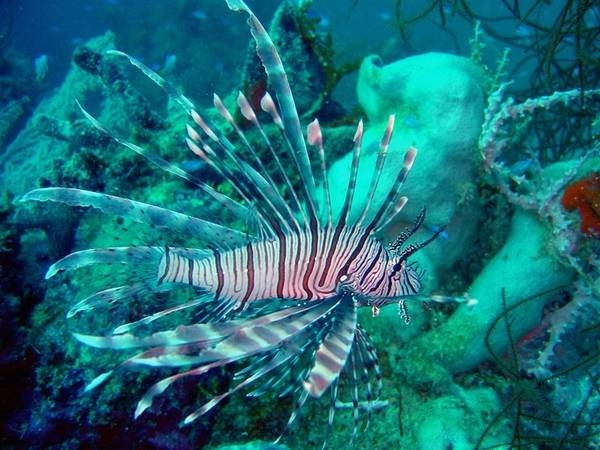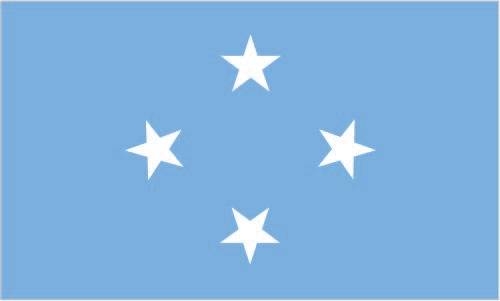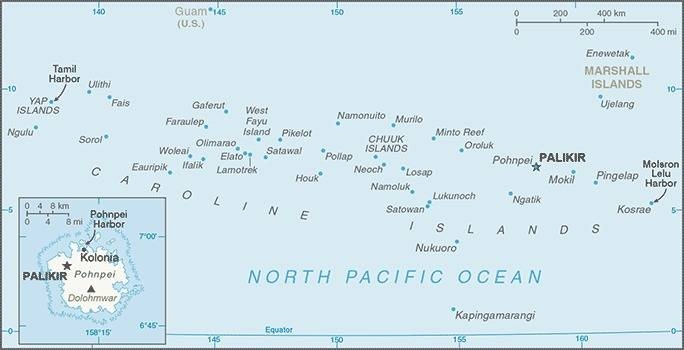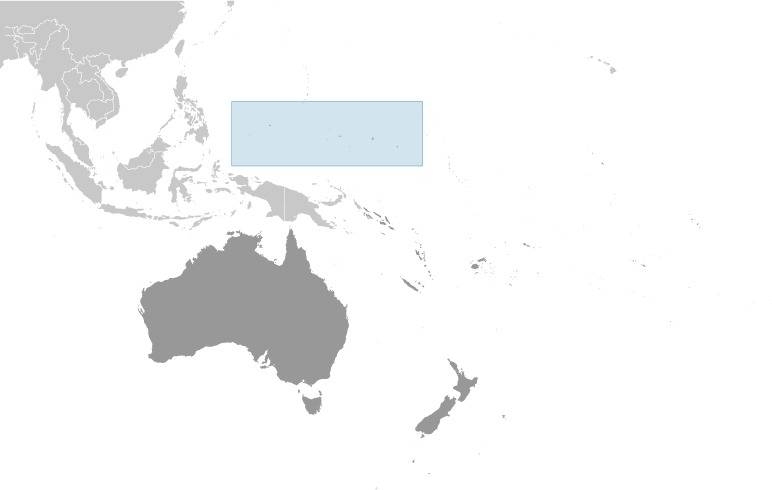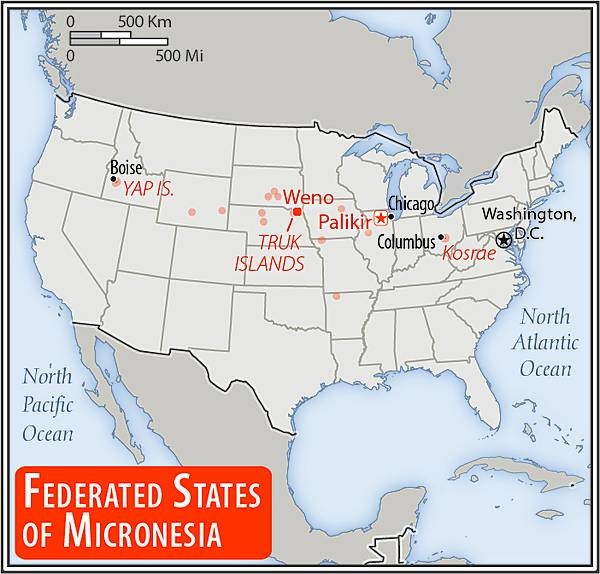Micronesia, Federated States of
Introduction
Background
Each of the four states that compose the Federated States of Micronesia (FSM) - Chuuk, Kosrae, Pohnpei, and Yap - has its own unique history and cultural traditions. The first humans arrived in what is now the FSM in the second millennium B.C. In the 800s A.D., construction of the artificial islets at the Nan Madol complex in Pohnpei began, with the main architecture being built around 1200. At its height, Nan Madol united the approximately 25,000 people of Pohnpei under the Saudeleur Dynasty. Around the same time, Kosrae was united in a kingdom centered in Leluh by 1250. Yap’s society became strictly hierarchical, with chiefs receiving tributes from islands up to 1,100 km (700 mi) away. Widespread human settlement in Chuuk began in the 1300s, and the different islands in the Chuuk Lagoon were frequently at war with one another.
Portuguese and Spanish explorers visited a few of the islands in the 1500s and Spain began exerting nominal, but not day-to-day, control over some of the islands - which they named the Caroline Islands - in the 1600s. Christian missionaries arrived in the 1800s, in particular to Chuuk and Kosrae. By the 1870s, nearly every Kosraean had converted to Christianity and religion continues to play an important role in daily life on the island. In 1899, Spain sold all of the FSM to Germany. Japan seized the islands in 1914 and was granted a League of Nations mandate to administer them in 1920. The Japanese navy built bases across most of the islands and headquartered their Pacific naval operations in Chuuk. The US bombed Chuuk in 1944 during Operation Hailstone in World War II, destroying 250 Japanese planes and 40 ships. The US military largely bypassed the other islands in its leapfrog campaign across the Pacific.
The FSM came under US administration as part of the Trust Territory of the Pacific Islands in 1947, which comprised six districts: Chuuk, the Marshall Islands, the Northern Mariana Islands, Palau, Pohnpei, and Yap; Kosrae was separated from Pohnpei into a separate district in 1977. In 1979, Chuuk, Kosrae, Pohnpei, and Yap ratified the FSM Constitution and declared independence while the other three districts opted to pursue separate political statuses. In 1982, the FSM signed a Compact of Free Association (COFA) with the US, which granted the FSM financial assistance and access to many US domestic programs in exchange for exclusive US military access and defense responsibilities; the COFA entered into force in 1986 and its funding was renewed in 2003. There are significant inter-island rivalries stemming from their different histories and cultures. Chuuk, the most populous but poorest state, has pushed for secession, but an independence referendum has been repeatedly postponed and may not be held.
Eligible Micronesians can live, work, and study in any part of the US and its territories without a visa - this privilege reduces stresses on the island economy and the environment. Micronesians serve in the US armed forces and military recruiting from the FSM, per capita, is higher than many US states.
Visit the Definitions and Notes page to view a description of each topic.
Geography
Location
Oceania, island group in the North Pacific Ocean, about three-quarters of the way from Hawaii to Indonesia
Geographic coordinates
6 55 N, 158 15 E
Map references
Oceania
Area
total: 702 sq km
land: 702 sq km
water: 0 sq km (fresh water only)
note: includes Pohnpei (Ponape), Chuuk (Truk) Islands, Yap Islands, and Kosrae (Kosaie)
Land boundaries
total: 0 km
Coastline
6,112 km
Maritime claims
territorial sea: 12 nm
exclusive economic zone: 200 nm
Climate
tropical; heavy year-round rainfall, especially in the eastern islands; located on southern edge of the typhoon belt with occasionally severe damage
Terrain
islands vary geologically from high mountainous islands to low, coral atolls; volcanic outcroppings on Pohnpei, Kosrae, and Chuuk
Elevation
highest point: Nanlaud on Pohnpei 782 m
lowest point: Pacific Ocean 0 m
Natural resources
timber, marine products, deep-seabed minerals, phosphate
Land use
agricultural land: 25.5% (2018 est.)
arable land: 2.3% (2018 est.)
permanent crops: 19.7% (2018 est.)
permanent pasture: 3.5% (2018 est.)
forest: 74.5% (2018 est.)
other: 0% (2018 est.)
Irrigated land
0 sq km (2022)
Population distribution
the majority of the populaton lives in the coastal areas of the high islands; the mountainous interior is largely uninhabited; less than half of the population lives in urban areas
Natural hazards
typhoons (June to December)
Geography - note
composed of four major island groups totaling 607 islands
People and Society
Nationality
noun: Micronesian(s)
adjective: Micronesian; Chuukese, Kosraen(s), Pohnpeian(s), Yapese
Ethnic groups
Chuukese/Mortlockese 49.3%, Pohnpeian 29.8%, Kosraean 6.3%, Yapese 5.7%, Yap outer islanders 5.1%, Polynesian 1.6%, Asian 1.4%, other 0.8% (2010 est.)
Languages
English (official and common language), Chuukese, Kosrean, Pohnpeian, Yapese, Ulithian, Woleaian, Nukuoro, Kapingamarangi
Religions
Roman Catholic 54.7%, Protestant 41.1% (includes Congregational 38.5%, Baptist 1.1%, Seventh Day Adventist 0.8%, Assembly of God 0.7%), Church of Jesus Christ 1.5%, other 1.9%, none 0.7%, unspecified 0.1% (2010 est.)
Age structure
0-14 years: 28.24% (male 14,585/female 14,129)
15-24 years: 18.62% (male 9,473/female 9,461)
25-54 years: 40.81% (male 19,998/female 21,493)
55-64 years: 7.38% (male 3,602/female 3,898)
65 years and over: 4.95% (male 2,260/female 2,776) (2021 est.)
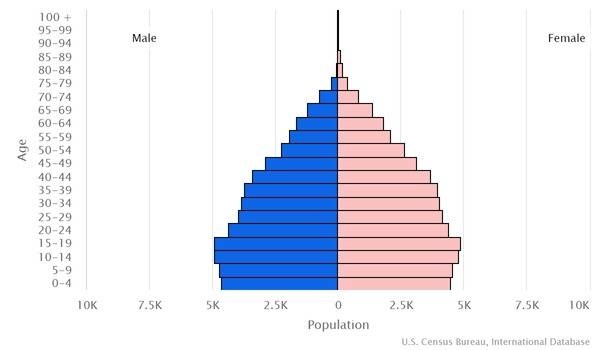
Dependency ratios
total dependency ratio: 57.7
youth dependency ratio: 48.4
elderly dependency ratio: 9.3
potential support ratio: 10.8 (2021 est.)
Median age
total: 26.3 years
male: 25.5 years
female: 27.1 years (2020 est.)
Net migration rate
-20.91 migrant(s)/1,000 population (2022 est.)
country comparison to the world: 229Population distribution
the majority of the populaton lives in the coastal areas of the high islands; the mountainous interior is largely uninhabited; less than half of the population lives in urban areas
Urbanization
urban population: 23.4% of total population (2023)
rate of urbanization: 1.52% annual rate of change (2020-25 est.)
Major urban areas - population
7,000 PALIKIR (capital) (2018)
Sex ratio
at birth: 1.05 male(s)/female
0-14 years: 1.03 male(s)/female
15-24 years: 1 male(s)/female
25-54 years: 0.92 male(s)/female
55-64 years: 0.92 male(s)/female
65 years and over: 0.57 male(s)/female
total population: 0.96 male(s)/female (2022 est.)
Maternal mortality ratio
88 deaths/100,000 live births (2017 est.)
country comparison to the world: 75Infant mortality rate
total: 21.9 deaths/1,000 live births
male: 25.02 deaths/1,000 live births
female: 18.63 deaths/1,000 live births (2022 est.)
Life expectancy at birth
total population: 74.44 years
male: 72.34 years
female: 76.66 years (2022 est.)
Drinking water source
improved: total: 78.6% of population
unimproved: total: 21.4% of population (2017 est.)
Current health expenditure
11.4% of GDP (2019)
Hospital bed density
3.2 beds/1,000 population
Sanitation facility access
improved: urban: NA
rural: NA
total: 88.3% of population
unimproved: urban: NA
rural: NA
total: 11.7% of population (2017 est.)
Major infectious diseases
degree of risk: high (2020)
food or waterborne diseases: bacterial diarrhea
vectorborne diseases: malaria
Alcohol consumption per capita
total: 1.59 liters of pure alcohol (2019 est.)
beer: 0.92 liters of pure alcohol (2019 est.)
wine: 0.13 liters of pure alcohol (2019 est.)
spirits: 0.52 liters of pure alcohol (2019 est.)
other alcohols: 0.01 liters of pure alcohol (2019 est.)
Literacy
total population: NA
male: NA
female: NA
Youth unemployment rate (ages 15-24)
total: 18.9%
male: 10.4%
female: 29.9% (2014)
Environment
Environment - current issues
overfishing; sea level rise due to climate change threatens land; water pollution, toxic pollution from mining; solid waste disposal
Environment - international agreements
party to: Biodiversity, Climate Change, Climate Change-Kyoto Protocol, Climate Change-Paris Agreement, Comprehensive Nuclear Test Ban, Desertification, Hazardous Wastes, Law of the Sea, Ozone Layer Protection
signed, but not ratified: none of the selected agreements
Air pollutants
particulate matter emissions: 10.23 micrograms per cubic meter (2016 est.)
carbon dioxide emissions: 0.14 megatons (2016 est.)
methane emissions: 0.02 megatons (2020 est.)
Climate
tropical; heavy year-round rainfall, especially in the eastern islands; located on southern edge of the typhoon belt with occasionally severe damage
Land use
agricultural land: 25.5% (2018 est.)
arable land: 2.3% (2018 est.)
permanent crops: 19.7% (2018 est.)
permanent pasture: 3.5% (2018 est.)
forest: 74.5% (2018 est.)
other: 0% (2018 est.)
Urbanization
urban population: 23.4% of total population (2023)
rate of urbanization: 1.52% annual rate of change (2020-25 est.)
Revenue from forest resources
forest revenues: 0.02% of GDP (2018 est.)
country comparison to the world: 143Major infectious diseases
degree of risk: high (2020)
food or waterborne diseases: bacterial diarrhea
vectorborne diseases: malaria
Waste and recycling
municipal solid waste generated annually: 26,040 tons (2016 est.)
Total renewable water resources
0 cubic meters (2017 est.)
Government
Country name
conventional long form: Federated States of Micronesia
conventional short form: none
local long form: Federated States of Micronesia
local short form: none
former: New Philippines; Caroline Islands; Trust Territory of the Pacific Islands, Ponape, Truk, and Yap Districts
abbreviation: FSM
etymology: the term "Micronesia" is a 19th-century construct of two Greek words, "micro" (small) and "nesoi" (islands), and refers to thousands of small islands in the western Pacific Ocean
Government type
federal republic in free association with the US
Capital
name: Palikir
geographic coordinates: 6 55 N, 158 09 E
time difference: UTC+11 (16 hours ahead of Washington, DC, during Standard Time)
time zone note: Micronesia has two time zones
note: Palikir became the new capital of the country in 1989, three years after independence; Kolonia, the former capital, remains the site for many foreign embassies; it also serves as the Pohnpei state capital
Administrative divisions
4 states; Chuuk (Truk), Kosrae (Kosaie), Pohnpei (Ponape), Yap
Independence
3 November 1986 (from the US-administered UN trusteeship)
National holiday
Constitution Day, 10 May (1979)
Constitution
history: drafted June 1975, ratified 1 October 1978, entered into force 10 May 1979
amendments: proposed by Congress, by a constitutional convention, or by public petition; passage requires approval by at least three-fourths majority vote in at least three fourths of the states; amended 1990; note – at least every 10 years as part of a general or special election, voters are asked whether to hold a constitution convention; a majority of affirmative votes is required to proceed; amended many times, last in 2019 (approval by referendum to hold a constitutional convention)
Legal system
mixed legal system of common and customary law
International law organization participation
has not submitted an ICJ jurisdiction declaration; non-party state to the ICCt
Citizenship
citizenship by birth: no
citizenship by descent only: at least one parent must be a citizen of FSM
dual citizenship recognized: no
residency requirement for naturalization: 5 years
Suffrage
18 years of age; universal
Executive branch
chief of state: President David W. PANUELO (since 11 May 2019); Vice President Yosiwo P. GEORGE (since 11 May 2015); note - the president is both chief of state and head of government
head of government: President David W. PANUELO (since 11 May 2019); Vice President Yosiwo P. GEORGE (since 11 May 2015)
cabinet: Cabinet includes the vice president and the heads of the 8 executive departments
elections/appointments: president and vice president indirectly elected by Congress from among the 4 'at large' senators for a 4-year term (eligible for a second term); election last held on 11 May 2019 (next to be held in 2023)
election results: David W. PANUELO elected president by Congress; Yosiwo P. GEORGE reelected vice president
Legislative branch
description: unicameral Congress (14 seats; 10 members directly elected in single-seat constituencies by simple majority vote to serve 2-year terms and 4 at- large members directly elected from each of the 4 states by proportional representation vote to serve 4-year terms)
elections: last held on 2 March 2021 (next to be held on March 2023)
election results: percent of vote - NA; seats - independent 14; composition as of July 2022 - men 13, women 1, percent of women 7.1%
Judicial branch
highest court(s): Federated States of Micronesia (FSM) Supreme Court (consists of the chief justice and not more than 5 associate justices and organized into appellate and criminal divisions)
judge selection and term of office: justices appointed by the FSM president with the approval of two-thirds of Congress; justices appointed for life
subordinate courts: the highest state-level courts are: Chuuk Supreme Court; Korsae State Court; Pohnpei State Court; Yap State Court
Political parties and leaders
no formal parties
International organization participation
ACP, ADB, AOSIS, FAO, G-77, IBRD, ICAO, ICRM, IDA, IFC, IFRCS, IMF, IOC, IOM, IPU, ITSO, ITU, MIGA, OPCW, PIF, Sparteca, SPC, UN, UNCTAD, UNESCO, WHO, WMO
Diplomatic representation in the US
chief of mission: Ambassador Akillino Harris SUSAIA (since 24 April 2017)
chancery: 1725 N Street NW, Washington, DC 20036
telephone: [1] (202) 223-4383
FAX: [1] (202) 223-4391
email address and website:
dcmission@fsmembassy.fm
https://fsmembassy.fm/
consulate(s) general: Honolulu, Portland (OR), Tamuning (Guam)
Diplomatic representation from the US
chief of mission: Ambassador Carmen G. CANTOR (since 31 January 2020)
embassy: 1286 US Embassy Place, Kolonia, Pohnpei, FM 96941
mailing address: 4120 Kolonia Place, Washington, D.C. 20521-4120
telephone: [691] 320-2187
FAX: [691] 320-2186
email address and website:
koloniaacs@state.gov
https://fm.usembassy.gov/
Flag description
light blue with four white five-pointed stars centered; the stars are arranged in a diamond pattern; blue symbolizes the Pacific Ocean, the stars represent the four island groups of Chuuk, Kosrae, Pohnpei, and Yap
National symbol(s)
four, five-pointed, white stars on a light blue field, hibiscus flower; national colors: light blue, white
National anthem
name: "Patriots of Micronesia"
lyrics/music: unknown/August Daniel BINZER
note: adopted 1991; also known as "Across All Micronesia"; the music is based on the 1820 German patriotic song "Ich hab mich ergeben", which was the West German national anthem from 1949-1950; variants of this tune are used in Johannes BRAHMS' "Festival Overture" and Gustav MAHLER's "Third Symphony"
National heritage
total World Heritage Sites: 1 (cultural)
selected World Heritage Site locales: Nan Madol: Ceremonial Center of Eastern Micronesia
Economy
Economic overview
Economic activity consists largely of subsistence farming and fishing, and government, which employs two-thirds of the adult working population and receives funding largely - 58% in 2013 – from Compact of Free Association assistance provided by the US. The islands have few commercially valuable mineral deposits. The potential for tourism is limited by isolation, lack of adequate facilities, and limited internal air and water transportation.
Under the terms of the original Compact, the US provided $1.3 billion in grants and aid from 1986 to 2001. The US and the Federated States of Micronesia (FSM) negotiated a second (amended) Compact agreement in 2002-03 that took effect in 2004. The amended Compact runs for a 20-year period to 2023; during which the US will provide roughly $2.1 billion to the FSM. The amended Compact also develops a trust fund for the FSM that will provide a comparable income stream beyond 2024 when Compact grants end.
The country's medium-term economic outlook appears fragile because of dependence on US assistance and lackluster performance of its small and stagnant private sector.
Real GDP (purchasing power parity)
$390 million (2019 est.)
$390 million (2018 est.)
$389 million (2017 est.)
note: data are in 2017 dollars
Real GDP growth rate
2% (2017 est.)
2.9% (2016 est.)
3.9% (2015 est.)
Real GDP per capita
$3,500 (2019 est.) note: data are in 2017 dollars
$3,500 (2018 est.) note: data are in 2017 dollars
$3,200 (2015 est.)
GDP (official exchange rate)
$328 million (2017 est.)
GDP - composition, by sector of origin
agriculture: 26.3% (2013 est.)
industry: 18.9% (2013 est.)
services: 54.8% (2013 est.)
GDP - composition, by end use
household consumption: 83.5% (2013 est.)
government consumption: 48.4% (2016 est.)
investment in fixed capital: 29.5% (2016 est.)
investment in inventories: 1.9% (2016 est.)
exports of goods and services: 27.5% (2016 est.)
imports of goods and services: -77% (2016 est.)
Agricultural products
coconuts, cassava, vegetables, sweet potatoes, bananas, pork, plantains, fruit, eggs, beef
Industries
tourism, construction; specialized aquaculture, craft items (shell and wood)
Labor force - by occupation
agriculture: 0.9%
industry: 5.2%
services: 93.9% (2013 est.)
note: two-thirds of the labor force are government employees
Youth unemployment rate (ages 15-24)
total: 18.9%
male: 10.4%
female: 29.9% (2014)
Population below poverty line
41.2% (2013 est.)
Gini Index coefficient - distribution of family income
40.1 (2013 est.)
country comparison to the world: 63Household income or consumption by percentage share
lowest 10%: NA
highest 10%: NA
Budget
revenues: 213.8 million (FY12/13 est.)
expenditures: 192.1 million (FY12/13 est.)
Fiscal year
1 October - 30 September
Current account balance
$12 million (2017 est.)
$11 million (2016 est.)
Exports - partners
Thailand 73%, Japan 10%, China 9% (2019)
Exports - commodities
fish and fish products, coral/shells, scrap metals, mollusks, office machinery/parts (2019)
Imports - partners
United States 32%, China 16%, Japan 14%, Taiwan 9%, Philippines 6%, South Korea 6% (2019)
Imports - commodities
poultry meats, netting, broadcasting equipment, various meats, fish products (2019)
Reserves of foreign exchange and gold
$203.7 million (31 December 2017 est.)
$135.1 million (31 December 2015 est.)
Debt - external
$93.6 million (2013 est.)
$93.5 million (2012 est.)
Exchange rates
the US dollar is used
Energy
Electricity access
electrification - total population: 82% (2018)
electrification - urban areas: 93.5% (2018)
electrification - rural areas: 78.7% (2018)
Coal
production: 0 metric tons (2020 est.)
consumption: 0 metric tons (2020 est.)
exports: 0 metric tons (2020 est.)
imports: 0 metric tons (2020 est.)
Petroleum
refined petroleum consumption: 1,200 bbl/day (2019 est.)
Natural gas
production: 0 cubic meters (2021 est.)
consumption: 0 cubic meters (2021 est.)
exports: 0 cubic meters (2021 est.)
imports: 0 cubic meters (2021 est.)
proven reserves: 0 cubic meters (2021 est.)
Carbon dioxide emissions
177,000 metric tonnes of CO2 (2019 est.)
from coal and metallurgical coke: 0 metric tonnes of CO2 (2019 est.)
from petroleum and other liquids: 177,000 metric tonnes of CO2 (2019 est.)
from consumed natural gas: 0 metric tonnes of CO2 (2019 est.)
Communications
Telephones - fixed lines
total subscriptions: 7,000 (2020 est.)
subscriptions per 100 inhabitants: 6 (2020 est.)
Telephones - mobile cellular
total subscriptions: 22,000 (2020 est.)
subscriptions per 100 inhabitants: 19 (2020 est.)
Telecommunication systems
general assessment: adequate system, the demand for mobile broadband is increasing due to mobile services being the primary and most wide-spread source for Internet access across the region (2020)
domestic: islands interconnected by shortwave radiotelephone, satellite (Intelsat) ground stations, and some coaxial and fiber-optic cable; mobile-cellular service available on the major islands; fixed line teledensity roughly 6 per 100 and mobile-cellular nearly 19 per 100 (2020)
international: country code - 691; landing points for the Chuukk-Pohnpei Cable and HANTRU-1 submarine cable system linking the Federated States of Micronesia and the US; satellite earth stations - 5 Intelsat (Pacific Ocean) (2019)
note: the COVID-19 pandemic continues to have a significant impact on production and supply chains globally; since 2020, some aspects of the telecom sector have experienced a downturn, particularly in mobile device production; progress toward 5G implementation has resumed, as well as upgrades to infrastructure; consumer spending on telecom services has increased due to the surge in demand for capacity and bandwidth; the crucial nature of telecom services as a tool for work and school from home is still evident, and the spike in this area has seen growth opportunities for development of new tools and increased services
Broadcast media
no TV broadcast stations; each state has a multi-channel cable service with TV transmissions carrying roughly 95% imported programming and 5% local programming; about a half-dozen radio stations (2009)
Internet users
total: 39,834 (2019 est.)
percent of population: 35% (2019 est.)
Broadband - fixed subscriptions
total: 6,000 (2020 est.)
subscriptions per 100 inhabitants: 5 (2020 est.)
Transportation
Airports - with paved runways
total: 6
1,524 to 2,437 m: 4
914 to 1,523 m: 2 (2021)
Roadways
note - paved and unpaved circumferential roads, most interior roads are unpaved
Merchant marine
total: 38
by type: general cargo 19, oil tanker 4, other 15 (2021)
Ports and terminals
major seaport(s): Colonia (Tamil Harbor), Molsron Lele Harbor, Pohnepi Harbor
Military and Security
Military and security forces
no military forces; Federated States of Micronesia National Police (includes a maritime wing)
Military - note
defense is the responsibility of the US
Micronesia has a "shiprider" agreement with the US, which allows local maritime law enforcement officers to embark on US Coast Guard (USCG) and US Navy (USN) vessels, including to board and search vessels suspected of violating laws or regulations within Micronesia's designated exclusive economic zone (EEZ) or on the high seas; "shiprider" agreements also enable USCG personnel and USN vessels with embarked USCG law enforcement personnel to work with host nations to protect critical regional resources (2022)
